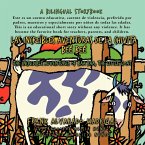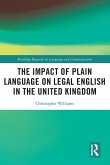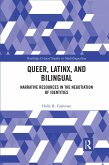Clara Ho-Yan Chan
Legal Translation and Bilingual Law Drafting in Hong Kong
Challenges and Interactions in Chinese Regions
Clara Ho-Yan Chan
Legal Translation and Bilingual Law Drafting in Hong Kong
Challenges and Interactions in Chinese Regions
- Broschiertes Buch
- Merkliste
- Auf die Merkliste
- Bewerten Bewerten
- Teilen
- Produkt teilen
- Produkterinnerung
- Produkterinnerung
Legal Translation and Bilingual Law Drafting in Hong Kong presents a systematic account from a cross-disciplinary perspective of the activities of legal translation and bilingual law drafting in the bilingual international city of Hong Kong and its interaction with Mainland China and Taiwan in the use of legal terminology. The study mainly examines the challenges posed to English-Chinese translation in the past three decades by elaborate drafting and terminological equivalence, and offers educational and research solutions. Its primary goals are to create legal Chinese that naturally…mehr
Andere Kunden interessierten sich auch für
![English and the Discourses of Colonialism English and the Discourses of Colonialism]() Alastair PennycookEnglish and the Discourses of Colonialism71,99 €
Alastair PennycookEnglish and the Discourses of Colonialism71,99 €![Guia Bilingue Legal Para Todos/ Bilingual Legal Guide for All Guia Bilingue Legal Para Todos/ Bilingual Legal Guide for All]() Yolanda J. Izurieta M. EdGuia Bilingue Legal Para Todos/ Bilingual Legal Guide for All34,99 €
Yolanda J. Izurieta M. EdGuia Bilingue Legal Para Todos/ Bilingual Legal Guide for All34,99 €![Catalogue of the Valuable Law Library of the Late Hon. Judge Dunkin [microform]: Comprising the Principal English and French Legal Authorities, Canada Catalogue of the Valuable Law Library of the Late Hon. Judge Dunkin [microform]: Comprising the Principal English and French Legal Authorities, Canada]() Christopher DunkinCatalogue of the Valuable Law Library of the Late Hon. Judge Dunkin [microform]: Comprising the Principal English and French Legal Authorities, Canada16,99 €
Christopher DunkinCatalogue of the Valuable Law Library of the Late Hon. Judge Dunkin [microform]: Comprising the Principal English and French Legal Authorities, Canada16,99 €![Hugs, Kisses and Stories Câlins, Bisous et Histoires Hugs, Kisses and Stories Câlins, Bisous et Histoires]() Melanie LausenHugs, Kisses and Stories Câlins, Bisous et Histoires27,99 €
Melanie LausenHugs, Kisses and Stories Câlins, Bisous et Histoires27,99 €![Las increíbles aventuras de la chivita Beé Beé - Bilingual Edition Las increíbles aventuras de la chivita Beé Beé - Bilingual Edition]() Frank Alvarado MadrigalLas increíbles aventuras de la chivita Beé Beé - Bilingual Edition20,99 €
Frank Alvarado MadrigalLas increíbles aventuras de la chivita Beé Beé - Bilingual Edition20,99 €![The Impact of Plain Language on Legal English in the United Kingdom The Impact of Plain Language on Legal English in the United Kingdom]() Christopher WilliamsThe Impact of Plain Language on Legal English in the United Kingdom64,99 €
Christopher WilliamsThe Impact of Plain Language on Legal English in the United Kingdom64,99 €![Queer, Latinx, and Bilingual Queer, Latinx, and Bilingual]() Holly CashmanQueer, Latinx, and Bilingual64,99 €
Holly CashmanQueer, Latinx, and Bilingual64,99 €-
-
Legal Translation and Bilingual Law Drafting in Hong Kong presents a systematic account from a cross-disciplinary perspective of the activities of legal translation and bilingual law drafting in the bilingual international city of Hong Kong and its interaction with Mainland China and Taiwan in the use of legal terminology. The study mainly examines the challenges posed to English-Chinese translation in the past three decades by elaborate drafting and terminological equivalence, and offers educational and research solutions. Its primary goals are to create legal Chinese that naturally accommodates common law concepts and statutes from the English legal system and to reconcile Chinese legal terms from the different legal systems adopted by Hong Kong, Mainland China and Taiwan. The new directions in legal translation and bilingual law drafting in Hong Kong will have implications for other Chinese regions and for the world. The book is intended for scholars, researchers, teachers and students of legal translation and legal linguistics, legal translators, lawyers and legal practitioners who are engaged in translation, as well as all persons who are interested in legal language and legal translation.
Hinweis: Dieser Artikel kann nur an eine deutsche Lieferadresse ausgeliefert werden.
Hinweis: Dieser Artikel kann nur an eine deutsche Lieferadresse ausgeliefert werden.
Produktdetails
- Produktdetails
- Verlag: Routledge
- Seitenzahl: 174
- Erscheinungstermin: 26. Mai 2020
- Englisch
- Abmessung: 234mm x 156mm x 10mm
- Gewicht: 275g
- ISBN-13: 9781138335912
- ISBN-10: 1138335916
- Artikelnr.: 59602941
- Herstellerkennzeichnung
- Libri GmbH
- Europaallee 1
- 36244 Bad Hersfeld
- gpsr@libri.de
- Verlag: Routledge
- Seitenzahl: 174
- Erscheinungstermin: 26. Mai 2020
- Englisch
- Abmessung: 234mm x 156mm x 10mm
- Gewicht: 275g
- ISBN-13: 9781138335912
- ISBN-10: 1138335916
- Artikelnr.: 59602941
- Herstellerkennzeichnung
- Libri GmbH
- Europaallee 1
- 36244 Bad Hersfeld
- gpsr@libri.de
Clara Ho-yan Chan is Associate Professor of the School of Humanities and Social Science, the Chinese University of Hong Kong, Shenzhen. Her research interests focus on language and law, especially legal translation, legal terminology and bilingual law drafting.
Table of Contents List of tables and figures Preface Acknowledgments 1 Introduction: about this book 1.1 Background and purpose 1.1.1 Legal translation in Modern China 1.1.2 Legal translation in Hong Kong 1.2 Review and framework 1.2.1 Hong Kong: translation of English laws and bilingual law drafting for the 1997 change of sovereignty 1.2.2 Mainland China and Taiwan: legal globalisation 1.3 Terminology 1.3.1 Legal Chinese 1.3.2 Chinese legal terminology 1.3.3 Legal translation 1.4 Organisation and technicalities 1.4.1 Structure and limitations 1.4.2 Romanisation and convention 2 Challenges in legal translation: a language perspective 2.1 Europeanisation of Chinese 2.1.1 Lexical changes 2.1.2 Morpho-syntactic changes 2.1.2.1 Affixation 2.1.2.2 Conjunctions 2.1.2.3 Pronouns 2.1.2.4 Pre-nominal modifiers and embedding levels 2.1.2.5 Passive voice 2.1.2.6 Other types of syntactic change 2.2 Europeanisation of legal Chinese 2.2.1 Legislation 2.2.1.1 Lexicon 2.2.1.2 Syntax (i) Huo (
) (or) . . . huo (
) (or) (ii) Prepositions and prepositional phrases (iii) Underpunctuation (iv) 'Empty verb'construction (v) Shi . . . de (
. . .
)/wei . . . de (
. . .
) construction (vi) Excessive use of nouns 2.2.2 Judgments 2.2.3 Legal documents 2.2.4 Legal translation textbook 2.2.5 Responses from different sectors 3 Challenges in legal translation: a legal perspective 3.1 'Equivalence' in Hong Kong bilingual legal terminology 3.2 Equivalence in Chinese legal terminology in three Chinese regions 3.2.1 Five translation categories in terms of equivalence 3.2.1.1Category 1 (near equivalents)-one or more similar foreign source term(s) with same renditions of same/similar meaning 3.2.1.2 Category 2 (near equivalents)-one or more similar foreign source term(s) with different renditions of same/similar meaning 3.2.1.3 Category 3 (partial or non-equivalents)-one or more similar foreign source terms with different renditions of different meanings 3.2.1.4 Category 4 (partial or non-equivalents)- different foreign source terms with different renditions of different meanings (partial or non-equivalents) 3.2.1.5 Category 5 (non-equivalents)-mistranslation 3.3 Case study of terminology in international agreements: intellectual property rights in Mainland China, Taiwan and Hong Kong 3.3.1 Introduction and methodology 3.3.2 'Layout-design', its Chinese translations and the measurement of equivalence (waiguan sheji (
) vs dianlu buju (
(
)) vs butu sheji (
(
)) 3.3.2.1 Mainland China: waiguan sheji (
) 3.3.2.2 Taiwan: dianlu buju (
(
)) 3.3.2.3 Hong Kong: butu sheji (
(
)) 3.3.3 Summary and conclusion 3.4 Concluding remarks 4 Education in meeting challenges 4.1 Education and training: theory and practice 4.2 Broad and balanced approach: first lecture on legal translation 4.2.1 A broad approach: legal systems, legal traditions and legal language 4.2.2 A balanced approach: views on the Chinese legal system 4.3 Interdisciplinary approach: language and law 4.3.1 Case study: a legal knowledge-based translation course for Hong Kong translation students 4.3.1.1 Background and aims 4.3.1.2 Design and contents 4.3.1.3 Feedback and reflections 4.3.2 Case study: an English-Chinese glossary of terminology for Hong Kong law students 4.3.2.1 Background and aims 4.3.2.2 Design and contents 4.3.2.3 Feedback and reflections 4.3.3 Master's programmes on language and law in three regions 4.4 Training for legal professionals and legal translators 4.4.1 Government law drafters 4.4.2 Amini-survey: use of Chinese by lawyers and legal translators 4.5 Concluding remarks x Contents 5 Research in meeting challenges 5.1 Major books and bilingual legal resources 5.1.1 Research books 5.1.2 Reference books 5.2 Two potential research areas 5.2.1 Enhancing language quality for bilingual legislation and judgments 5.2.1.1 Co-drafting of bilingual legislation: plain language drafting 5.2.1.2 Translation of judgments: Chinese proficiency and language style 5.2.2 Comparative study of legal terminology and legal glossary compilation 5.2.2.1 Relations with comparative law and existing works 5.2.2.2 Framework for comparison 6 Conclusion: trends and prospects 6.1 Training practitioners with language and law skills: status of legal translation 6.2 Research work on terminology comparison: 'universal' translation methods 6.3 Epilogue: a new era with new visions 6.3.1 Past experience 6.3.2 Development for the future Index
) (or) . . . huo (
) (or) (ii) Prepositions and prepositional phrases (iii) Underpunctuation (iv) 'Empty verb'construction (v) Shi . . . de (
. . .
)/wei . . . de (
. . .
) construction (vi) Excessive use of nouns 2.2.2 Judgments 2.2.3 Legal documents 2.2.4 Legal translation textbook 2.2.5 Responses from different sectors 3 Challenges in legal translation: a legal perspective 3.1 'Equivalence' in Hong Kong bilingual legal terminology 3.2 Equivalence in Chinese legal terminology in three Chinese regions 3.2.1 Five translation categories in terms of equivalence 3.2.1.1Category 1 (near equivalents)-one or more similar foreign source term(s) with same renditions of same/similar meaning 3.2.1.2 Category 2 (near equivalents)-one or more similar foreign source term(s) with different renditions of same/similar meaning 3.2.1.3 Category 3 (partial or non-equivalents)-one or more similar foreign source terms with different renditions of different meanings 3.2.1.4 Category 4 (partial or non-equivalents)- different foreign source terms with different renditions of different meanings (partial or non-equivalents) 3.2.1.5 Category 5 (non-equivalents)-mistranslation 3.3 Case study of terminology in international agreements: intellectual property rights in Mainland China, Taiwan and Hong Kong 3.3.1 Introduction and methodology 3.3.2 'Layout-design', its Chinese translations and the measurement of equivalence (waiguan sheji (
) vs dianlu buju (
(
)) vs butu sheji (
(
)) 3.3.2.1 Mainland China: waiguan sheji (
) 3.3.2.2 Taiwan: dianlu buju (
(
)) 3.3.2.3 Hong Kong: butu sheji (
(
)) 3.3.3 Summary and conclusion 3.4 Concluding remarks 4 Education in meeting challenges 4.1 Education and training: theory and practice 4.2 Broad and balanced approach: first lecture on legal translation 4.2.1 A broad approach: legal systems, legal traditions and legal language 4.2.2 A balanced approach: views on the Chinese legal system 4.3 Interdisciplinary approach: language and law 4.3.1 Case study: a legal knowledge-based translation course for Hong Kong translation students 4.3.1.1 Background and aims 4.3.1.2 Design and contents 4.3.1.3 Feedback and reflections 4.3.2 Case study: an English-Chinese glossary of terminology for Hong Kong law students 4.3.2.1 Background and aims 4.3.2.2 Design and contents 4.3.2.3 Feedback and reflections 4.3.3 Master's programmes on language and law in three regions 4.4 Training for legal professionals and legal translators 4.4.1 Government law drafters 4.4.2 Amini-survey: use of Chinese by lawyers and legal translators 4.5 Concluding remarks x Contents 5 Research in meeting challenges 5.1 Major books and bilingual legal resources 5.1.1 Research books 5.1.2 Reference books 5.2 Two potential research areas 5.2.1 Enhancing language quality for bilingual legislation and judgments 5.2.1.1 Co-drafting of bilingual legislation: plain language drafting 5.2.1.2 Translation of judgments: Chinese proficiency and language style 5.2.2 Comparative study of legal terminology and legal glossary compilation 5.2.2.1 Relations with comparative law and existing works 5.2.2.2 Framework for comparison 6 Conclusion: trends and prospects 6.1 Training practitioners with language and law skills: status of legal translation 6.2 Research work on terminology comparison: 'universal' translation methods 6.3 Epilogue: a new era with new visions 6.3.1 Past experience 6.3.2 Development for the future Index
Table of Contents List of tables and figures Preface Acknowledgments 1 Introduction: about this book 1.1 Background and purpose 1.1.1 Legal translation in Modern China 1.1.2 Legal translation in Hong Kong 1.2 Review and framework 1.2.1 Hong Kong: translation of English laws and bilingual law drafting for the 1997 change of sovereignty 1.2.2 Mainland China and Taiwan: legal globalisation 1.3 Terminology 1.3.1 Legal Chinese 1.3.2 Chinese legal terminology 1.3.3 Legal translation 1.4 Organisation and technicalities 1.4.1 Structure and limitations 1.4.2 Romanisation and convention 2 Challenges in legal translation: a language perspective 2.1 Europeanisation of Chinese 2.1.1 Lexical changes 2.1.2 Morpho-syntactic changes 2.1.2.1 Affixation 2.1.2.2 Conjunctions 2.1.2.3 Pronouns 2.1.2.4 Pre-nominal modifiers and embedding levels 2.1.2.5 Passive voice 2.1.2.6 Other types of syntactic change 2.2 Europeanisation of legal Chinese 2.2.1 Legislation 2.2.1.1 Lexicon 2.2.1.2 Syntax (i) Huo (
) (or) . . . huo (
) (or) (ii) Prepositions and prepositional phrases (iii) Underpunctuation (iv) 'Empty verb'construction (v) Shi . . . de (
. . .
)/wei . . . de (
. . .
) construction (vi) Excessive use of nouns 2.2.2 Judgments 2.2.3 Legal documents 2.2.4 Legal translation textbook 2.2.5 Responses from different sectors 3 Challenges in legal translation: a legal perspective 3.1 'Equivalence' in Hong Kong bilingual legal terminology 3.2 Equivalence in Chinese legal terminology in three Chinese regions 3.2.1 Five translation categories in terms of equivalence 3.2.1.1Category 1 (near equivalents)-one or more similar foreign source term(s) with same renditions of same/similar meaning 3.2.1.2 Category 2 (near equivalents)-one or more similar foreign source term(s) with different renditions of same/similar meaning 3.2.1.3 Category 3 (partial or non-equivalents)-one or more similar foreign source terms with different renditions of different meanings 3.2.1.4 Category 4 (partial or non-equivalents)- different foreign source terms with different renditions of different meanings (partial or non-equivalents) 3.2.1.5 Category 5 (non-equivalents)-mistranslation 3.3 Case study of terminology in international agreements: intellectual property rights in Mainland China, Taiwan and Hong Kong 3.3.1 Introduction and methodology 3.3.2 'Layout-design', its Chinese translations and the measurement of equivalence (waiguan sheji (
) vs dianlu buju (
(
)) vs butu sheji (
(
)) 3.3.2.1 Mainland China: waiguan sheji (
) 3.3.2.2 Taiwan: dianlu buju (
(
)) 3.3.2.3 Hong Kong: butu sheji (
(
)) 3.3.3 Summary and conclusion 3.4 Concluding remarks 4 Education in meeting challenges 4.1 Education and training: theory and practice 4.2 Broad and balanced approach: first lecture on legal translation 4.2.1 A broad approach: legal systems, legal traditions and legal language 4.2.2 A balanced approach: views on the Chinese legal system 4.3 Interdisciplinary approach: language and law 4.3.1 Case study: a legal knowledge-based translation course for Hong Kong translation students 4.3.1.1 Background and aims 4.3.1.2 Design and contents 4.3.1.3 Feedback and reflections 4.3.2 Case study: an English-Chinese glossary of terminology for Hong Kong law students 4.3.2.1 Background and aims 4.3.2.2 Design and contents 4.3.2.3 Feedback and reflections 4.3.3 Master's programmes on language and law in three regions 4.4 Training for legal professionals and legal translators 4.4.1 Government law drafters 4.4.2 Amini-survey: use of Chinese by lawyers and legal translators 4.5 Concluding remarks x Contents 5 Research in meeting challenges 5.1 Major books and bilingual legal resources 5.1.1 Research books 5.1.2 Reference books 5.2 Two potential research areas 5.2.1 Enhancing language quality for bilingual legislation and judgments 5.2.1.1 Co-drafting of bilingual legislation: plain language drafting 5.2.1.2 Translation of judgments: Chinese proficiency and language style 5.2.2 Comparative study of legal terminology and legal glossary compilation 5.2.2.1 Relations with comparative law and existing works 5.2.2.2 Framework for comparison 6 Conclusion: trends and prospects 6.1 Training practitioners with language and law skills: status of legal translation 6.2 Research work on terminology comparison: 'universal' translation methods 6.3 Epilogue: a new era with new visions 6.3.1 Past experience 6.3.2 Development for the future Index
) (or) . . . huo (
) (or) (ii) Prepositions and prepositional phrases (iii) Underpunctuation (iv) 'Empty verb'construction (v) Shi . . . de (
. . .
)/wei . . . de (
. . .
) construction (vi) Excessive use of nouns 2.2.2 Judgments 2.2.3 Legal documents 2.2.4 Legal translation textbook 2.2.5 Responses from different sectors 3 Challenges in legal translation: a legal perspective 3.1 'Equivalence' in Hong Kong bilingual legal terminology 3.2 Equivalence in Chinese legal terminology in three Chinese regions 3.2.1 Five translation categories in terms of equivalence 3.2.1.1Category 1 (near equivalents)-one or more similar foreign source term(s) with same renditions of same/similar meaning 3.2.1.2 Category 2 (near equivalents)-one or more similar foreign source term(s) with different renditions of same/similar meaning 3.2.1.3 Category 3 (partial or non-equivalents)-one or more similar foreign source terms with different renditions of different meanings 3.2.1.4 Category 4 (partial or non-equivalents)- different foreign source terms with different renditions of different meanings (partial or non-equivalents) 3.2.1.5 Category 5 (non-equivalents)-mistranslation 3.3 Case study of terminology in international agreements: intellectual property rights in Mainland China, Taiwan and Hong Kong 3.3.1 Introduction and methodology 3.3.2 'Layout-design', its Chinese translations and the measurement of equivalence (waiguan sheji (
) vs dianlu buju (
(
)) vs butu sheji (
(
)) 3.3.2.1 Mainland China: waiguan sheji (
) 3.3.2.2 Taiwan: dianlu buju (
(
)) 3.3.2.3 Hong Kong: butu sheji (
(
)) 3.3.3 Summary and conclusion 3.4 Concluding remarks 4 Education in meeting challenges 4.1 Education and training: theory and practice 4.2 Broad and balanced approach: first lecture on legal translation 4.2.1 A broad approach: legal systems, legal traditions and legal language 4.2.2 A balanced approach: views on the Chinese legal system 4.3 Interdisciplinary approach: language and law 4.3.1 Case study: a legal knowledge-based translation course for Hong Kong translation students 4.3.1.1 Background and aims 4.3.1.2 Design and contents 4.3.1.3 Feedback and reflections 4.3.2 Case study: an English-Chinese glossary of terminology for Hong Kong law students 4.3.2.1 Background and aims 4.3.2.2 Design and contents 4.3.2.3 Feedback and reflections 4.3.3 Master's programmes on language and law in three regions 4.4 Training for legal professionals and legal translators 4.4.1 Government law drafters 4.4.2 Amini-survey: use of Chinese by lawyers and legal translators 4.5 Concluding remarks x Contents 5 Research in meeting challenges 5.1 Major books and bilingual legal resources 5.1.1 Research books 5.1.2 Reference books 5.2 Two potential research areas 5.2.1 Enhancing language quality for bilingual legislation and judgments 5.2.1.1 Co-drafting of bilingual legislation: plain language drafting 5.2.1.2 Translation of judgments: Chinese proficiency and language style 5.2.2 Comparative study of legal terminology and legal glossary compilation 5.2.2.1 Relations with comparative law and existing works 5.2.2.2 Framework for comparison 6 Conclusion: trends and prospects 6.1 Training practitioners with language and law skills: status of legal translation 6.2 Research work on terminology comparison: 'universal' translation methods 6.3 Epilogue: a new era with new visions 6.3.1 Past experience 6.3.2 Development for the future Index

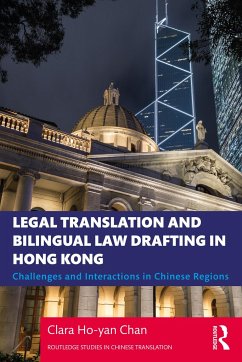
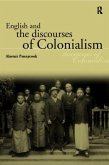
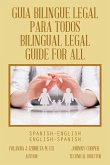
![Catalogue of the Valuable Law Library of the Late Hon. Judge Dunkin [microform]: Comprising the Principal English and French Legal Authorities, Canada Catalogue of the Valuable Law Library of the Late Hon. Judge Dunkin [microform]: Comprising the Principal English and French Legal Authorities, Canada](https://bilder.buecher.de/produkte/66/66124/66124408m.jpg)

